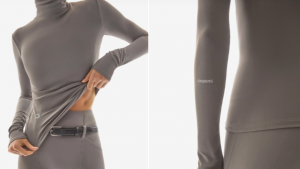First Published in
The disposable quality of the ever-renewable "new" in fashion offends sustainability on the levels of pollution, waste and obsolescence. Every season outdates previous trends and for a truly eco-conscious fashion industry, image-conscious fashionistas may have to curb their buying.
Capable of leading a revolution in the throwaway culture, local fashion designers are in a position of responsibility. Even superficial choices such as sustainable fibres and dyes that add aesthetic value to haute couture collections can influence consumer desire and buying habits on a larger scale. However, it's the very business model – internet distribution friendly, high-quality, made-to-order, longevity of style and beauty – that is significantly more sustainable than cheap mass-production.
Nonetheless, for a radical global shift it will be essential for larger retailers to position sustainable green design as priority, no longer a party trick. Internationally, American Apparel and Stewart+Brown have long led the way, while the recently launched Nau, which has been conceptualised according to cradle-to-cradle sustainability, has just moved the goalposts.
Locally, Woolworths continues to be the leader in ethical shopping, launching South Africa's first large-scale sustainable fibre collection in August. With 100% organic cotton T-shirts, jeans, shirts and underwear; bamboo shirts and socks; and garments made with 5% organic cotton in virtually every clothing department, including menswear, womenswear and kidswear; this is set to challenge the local clothing industry and consumers.
"As an organisation, Woolworths believes it has a responsibility to take the lead, both in terms of our own behaviour and in terms of providing our customers with choices that fit with their own ethos. Our green label is about being aware of our place in the ecosystem, about realising that everything we do has consequences," Charmaine Huet, head of marketing at Woolworths, explains.
The consequences in fashion are certainly significant. Even if 5% may seem like lip service, each incremental choice in the fashion industry has a quantifiable environmental impact due to the economies of scale. Small changes in the production line, material and usage equate to big environmental differences, says Pat Foure of the Clothing and Textiles Environmental Linkage Centre. For instance, Nike's decision to use just 3% organic cotton in its T-shirts and socks equated into the environment being saved from 330 tonnes of toxic chemicals over a three-year period.
Well-publicised natural materials such as organic cotton, bamboo, soy, tencel and hemp are increasingly being complemented with ever more ingenuity. Cloth made from pulverised bark harvested from the wild Mutuba Fig tree in Uganda is offering an alternative to otherwise oil-manufactured polar fleece. Man-made fibres such as microfibre, cellulose fibres and recycled plastics are also good alternatives, especially in shoes.
Choosing appropriate materials is a good start, but being aware of the production cycle is often even more important. "One textile mill may use over 200 litres of water to produce a kilogram of fabric whereas another may have improved their process and use less than 40 litres of water to produce a very similar-looking fabric.
When a designer is working with orders for many thousands of garments requiring literally tons of fabric, the water saved by specifying the lower water user could equate to the household water requirements of a large town. Much of the water consumed in the process of textile manufacture is hot, therefore a reduction in water consumed means less energy – usually electricity – consumed," Foure explains.
Avoiding the production and sourcing stages completely, using material that already exists and would otherwise end up in landfills is even better and closes the production-waste loop. According to a 2006 study by the Salvation Army and the University College Northampton, "The re-use of 1 tonne of polyester garments uses only 1,8% of the energy required for manufacture of these goods from virgin materials and the re-use of 1 tonne of cotton clothing uses only 2,6% of the energy required to manufacture those from virgin materials."
Whether from a post-consumer stage (recycling or repurposing second-hand garments) or a post-industrial stage (using factory offcuts and waste), repurposed and recycled clothes have already given birth to a ready-made youth streetwear style. Local designer Darkie and French design collective Andrea Crews embody this aesthetic, while Adriana Bertini's condom couture pushes this approach completely out of the envelope.
However, if someone else's recycled clothes would still use at least 2,6% of energy, it follows that a person's own clothing would use 0%. The greenest fashion choices are clothes that last long, are multifunctional, continue to satisfy taste and wash green – a strong case for buying high-quality local design. With Craig Jacobs's 100% organic line and even Gavin Rajah's organic dye process, the local industry is starting to gear up for a revolution.
Wash green? Yes, more than 75% of the energy consumed in the lifecycle of a garment is not in its production but in the laundering – warm washing cycles, dry cleaning, ironing and tumble-drying. Using cold water reduces the impact by 10%, while not tumble-drying reduces the impact by 50%.
While many of these measures may seem almost impossible, technology is trying to keep pace with human habits. Even shopping online reduces the environmental impact of superfluous travel and brick-and-mortar establishments. Still pandering to the fitting room? Order the perfect fit from Bodymetrics, which uses 3D body scanning to create a virtual replica of a person's body dimensions. Having first rolled out the concept with tailored jeans and swimsuits, the company is now collaborating with Vivienne Westwood, Nick Tentis and Nick Holland to offer a figure-perfect range of suits.
Multifunctional aspects of garments are also being ushered out of the realm of science fiction. Solar-panelled jackets and bikinis that power your iPod and cellphones might still be geeky, but the possibilities extend further. Research conducted by London College of Fashion and UK telecoms firm BT predicts shoes that can be made on demand by a 3D printer, fabrics laced with LEDs that can change patterns and colours, and clothing that communicates with the wearer's gadgets.
Tackling the washing machine, Clemson University is researching "self-cleaning" clothing – well, at least more dirt resistant. By coating clothes with the polymer film that they have devised, they predict that clothes could be cleaned with the wipe of a damp cloth. The polymer is based on the properties of lotus leaves, which cause water to bead up, collect dirt and roll away.
Still, we don't need that much technology to just get the basics right: Non-disposable fashion that promotes a sustainable lifestyle rather than the throwaway culture. Even Stella McCartney agrees. Having promoted animal rights in her fashion design since 1998 and become a poster child for ethical haute couture, she recently commented: "People need to start looking at the product, and if they like it, that's all that matters. If it has an ethical or ecological edge, that's a huge bonus."






















